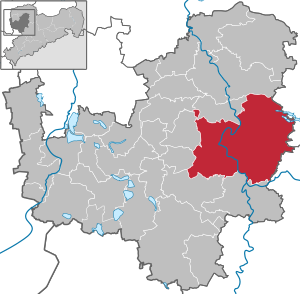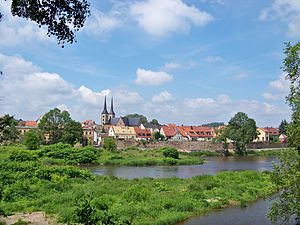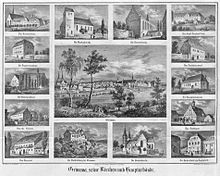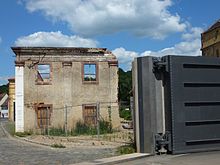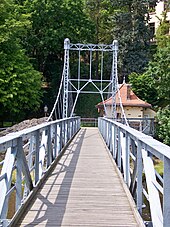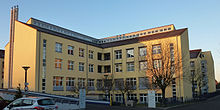Grimma
| coat of arms | Germany map | |
|---|---|---|

|
Coordinates: 51 ° 14 ' N , 12 ° 44' E |
|
| Basic data | ||
| State : | Saxony | |
| County : | Leipzig | |
| Height : | 128 m above sea level NHN | |
| Area : | 218.24 km 2 | |
| Residents: | 28,173 (Dec. 31, 2019) | |
| Population density : | 129 inhabitants per km 2 | |
| Postal code : | 04668 | |
| Primaries : | 03437, 034382, 034384, 034386 | |
| License plate : | L , BNA, GHA, GRM, MTL, WUR | |
| Community key : | 14 7 29 160 | |
City administration address : |
Market 16/17 04668 Grimma |
|
| Website : | ||
| Lord Mayor : | Matthias Berger (independent) | |
| Location of the city of Grimma in the Leipzig district | ||
Grimma is a large district town in the Leipzig district . The medium-sized town in the valley of the Mulde is the fourth largest city in Saxony by area . It was first mentioned in a document in 1200, the area only grew through numerous incorporations in the 20th and 21st centuries. The historic old town also includes most of the parish's sights, and there are also many old sacred buildings in the 64 districts.
geography
Surname
The Old Sorbian word "grim" means "low-lying terrain surrounded by water and wet meadows". This term was also used for the settlement. Already known as "Grimme, Grymme" in 1160 and "Grymm" in 1243, the "a" has been used as the end of a word since the 16th century in the course of the development of the language of the office.
location
The city is located in the North Saxon plateau and hill country 25 km southeast of Leipzig and approx. 16 km south of Wurzen in the valley of the river Mulde . With a total area of around 217 km² - due to numerous incorporations in 2011 and 2012 - and around 30,000 inhabitants, Grimma is the largest city or municipality in the district of Leipzig and the fourth largest city in Saxony in terms of area.
Grimma was severely affected by the floods in 2002 and May / June 2013 .
Localities
The city of Grimma includes 13 localities with a total of 64 districts:
- Beiersdorf
- Böhlen with Seidewitz
- Döben with Dorna , Grechwitz and Neunitz
- Dürrweitzschen with Motterwitz and Muschau
- Großbardau with Waldbardau , Kleinbardau and Bernbruch
- Großbothen with Kleinbothen and Schaddel
- Höfgen with Kaditzsch , Schkortitz and Naundorf
- Kasten with Förstgen
- Leipnitz with Frauendorf , Keiselwitz , Kuckeland , Papsdorf and Zeunitz
- Mutzschen with Gastewitz , Göttwitz , Jeesewitz , Köllmichen , Prösitz , Roda , Wagelwitz and Wetteritz
- Nerchau with stretchers , Cannewitz , Deditz , Denkwitz , Fremdiswalde , Gaudichsroda , Golzern , Gornewitz , Grottewitz , Löbschütz , Schmorditz , Serka , Thümmlitz and Würschwitz
- Ragewitz with Bröhsen , Haubitz , Pöhsig and Zaschwitz
- Zschoppach with Draschwitz , Nauberg , Ostrau and Poischwitz
In addition to the city center, there are also the districts of Hohnstädt , Grimma-West and Grimma-Süd
history
The strategically good location on the Mulde prompted Margrave Otto the Rich to build a settlement in 1170 . So the first Slavic settlements arose before the first documentary mention from 1200. In 1220 Grimma received city rights .
Meissnian margraves and the Saxon electors often resided in the castle. Albrecht the Courageous , the progenitor of the Saxon royal family, was born here. He therefore called himself Junker von Grym on his pilgrimage to Palestine . The first mention of the vigilante group Die Geharnischten in the Torgau , Oschatz and Grimma city union, which achieved historical fame in the Wurzen feud in 1542. The residents built the first permanent Muldenbrücke and developed a self-confident and enterprising middle class. In the 14th century, Grimma was in an economic boom. Even when the economic center of the region shifted more and more to Leipzig, Grimma has remained a flourishing location to this day.
Several state parliaments have been held in Grimma since 1440 . In the state parliament of 1458, Elector Friedrich the Meek founded the Leipzig New Year's Fair. Here negotiated 1511–1546 delegates from the two Saxon lines; Forty-year disputes over coinage and mining issues were settled through the "Grimmaische Machtspruch". (See also " Saxon coin separation ".)
In 1523 Katharina von Bora , who later became Martin Luther's wife , left the Nimbschen monastery near Grimma with other nuns .
The city brewery was founded around 1300 (Hildebrandt brewery since 1858, Frohberg brewery since 1872/1880, city brewery until around 1918). The name “Frohberg” comes from this brewery for one of the two widespread types of bottom-fermenting brewer's yeast ( Saccharomyces pastorianus or S. carlsbergensis ), the other type is named after Saaz (today: Žatec) (by Paul Lindner ).
In 1857 the Catholic Church of St. Trinity was consecrated.
From 1952 Grimma was the district town of the Grimma district and from 1994 to 2008 of the Muldental district and now has the status of a major district town .
Flood

Numerous houses in the old town were destroyed or severely damaged by the flood on August 13, 2002 ; in the meantime, however, almost all of them have been rebuilt. The historic Mulde bridge was destroyed by the flood and was rebuilt in September 2009 using a flood-adapted construction method. It was opened to traffic again on August 19, 2012. A monument made of Rochlitz porphyry by Friedhelm Lach commemorates the flood disaster.
In May / June 2013, the rebuilt city was hit by a new flood catastrophe with similar consequences for the old town as in August 2002. The reconstructed Mulde bridge withstood the new flood wave, and the improved construction of the structure prevented the flood effects of the bridge from backwater compared to 2002 be decreased.
The damage caused by the two floods was in the three-digit million range: According to MDR information, the damage balance in 2002 was around 250 million euros; In 2013 it was another 150 million euros.
To protect the city, existing building walls were upgraded after 2013 and a free-standing flood protection wall with lockable gates and an underground cut-off wall as a bored pile wall were built.
Incorporations
The suburb of Amtshaus was incorporated into Grimma in 1872. The Nimbschen monastery followed in 1948. On January 1, 1952, Hohnstädt was incorporated. Three parishes were added in 1994. Großbardau followed in 2006. At the beginning of 2011, Nerchau with 14 districts after a referendum on June 6, 2010, Thümmlitzwalde with 21 districts after an unification agreement and the northern districts of Großbothen were added. On September 18, 2011, the citizens of Mutzschen and the associated districts decided to merge with the city of Grimma. This took place on January 1, 2012.
Exile on the Mulde: The Thomaner 1943–1945 in the Princely School of Grimma
During the Allied bombing raids on Leipzig on December 4, 1943, the alumni of the St. Thomas Choir in Hillerstraße was also badly damaged: a bomb hit made it impossible to live in; the Thomaner needed a new, safe home at short notice. How the contact to Grimma came about can no longer be precisely proven. One thing is certain: the very next day - Sunday, December 5, 1943 - Cantor Günther Ramin and his choir found shelter in the Mulde city: the Fürstenschule zu Grimma became an alternative . The accommodation, which was initially intended to be a temporary solution, turned into eighteen months. From Grimma, the Thomaner regularly traveled to Leipzig for their motet performances and to numerous appearances in many places in Germany.
On December 18, 1993, the Thomaner sang again in the Frauenkirche Grimma - with Bach's Christmas Oratorio they commemorated their concert in the same church with the same musical work exactly 50 years ago to the day and the year and a half when the Thomanern was home to the Mulde town.
Population development
(from December 31, 2003):
|
|
politics
City council
The city council is the municipal representative body of the city of Grimma. Every five years, citizens decide on the allocation of seats in a general, direct, free, equal and secret ballot.
mayor
Matthias Berger was confirmed in office in June 2015 with almost 90% of the votes.
Town twinning
Sister cities of Grimma are
-
 Bron (Métropole de Lyon) in France, since 1971
Bron (Métropole de Lyon) in France, since 1971 -
 Vineyard in Baden-Württemberg, since 1990
Vineyard in Baden-Württemberg, since 1990 -
 Rüdesheim (Nahe) in Rhineland-Palatinate, since 1995
Rüdesheim (Nahe) in Rhineland-Palatinate, since 1995 -
 Leduc in Canada since 2002
Leduc in Canada since 2002 -
 Gezer in Israel since 2011
Gezer in Israel since 2011
Culture and sights
- see also: List of cultural monuments in Grimma
Attractions


The main attraction of Grimma is the historic old town on the banks of the Mulde with numerous monuments from different epochs (see the following list). It measures around three quarters of a kilometer from south to north and half a kilometer from east to west. This makes it the largest old town after Leipzig both in West Saxony and in the former administrative district of Leipzig , the current administrative district of Leipzig .
- The old Mulde bridge , built between 1716 and 1719 based on designs by the Baroque master builder Matthäus Daniel Pöppelmann , was destroyed in the 2002 flood. After a three-year reconstruction period, it was reopened in August 2012.
- The suspension bridge over the Mulde from 1925 is a pedestrian bridge and with 80 m the longest suspension bridge in Saxony. It connects the city forest with the city side of Grimmas, u. a. with the Gattersburg .
- A replica of the Saxon Post Distance Column from 1723 stands at the former Leipzig Gate.
- The original block of letters from the matching column from the former bridge gate is exhibited in the town hall foyer.
- In the historic old town, the Renaissance town hall stands out as the center of the city.
- In Grimma there are buildings from the most varied of style epochs:
- the St. Augustin monastery church , which is no longer used as a church, but as an exhibition, concert and culture hall. Together with the St. Augustin High School (architect: Hugo Nauck ), it forms a special architectural ensemble for walkers on the other side of the Mulde, which today is one of the most well-known cityscapes of the Mulde city
- the district museum (former girls' school)
- the former print shop " Seume -Haus" in the oldest Renaissance house on the market
- the Rathausgalerie
- the "Stadtgut", a baroque house on the market
- former medieval hospital "Zum Heiligen Kreuz"
- in Hohnstädt the Seume memorial in the “Göschenhaus” of the publisher and printer Georg Joachim Göschen
- in Höfgen the fortified church Höfgen , the monument smithy (formerly a farm, now the four-sided courtyard is used as an event location and a podium for the fine arts. It is under monument protection.) and the two technical display systems ship and water mill
- The 12th century church in Döben is of Romanesque origin.
- The Jutta Park together with the Bismarck Tower is considered a “place of rest”. From the tower you have a view of the surrounding area. There is a sound installation inside the tower. The park, lined with sculptures, was laid out in 1900 in the English style.
- The Nimbschen Monastery is a former Cistercian monastery . Katharina von Bora , who later became Martin Luther's wife , also lived here . She fled from there on Easter vigil in 1523 with other nuns. Today the site of the Reformation history can still be visited. But only the ruins of a single building remain of the monastery. The Luther Trail leads through Nimbschen.
- Two motor ships operate between Höfgen and Grimma. And a yaw ferry connects the banks of Nimbschen and Höfgen.
- The Grimma Castle is the oldest secular witness of the city, it was rebuilt (in 2009) to the Justice Center.
- The former princely and state school, today's St. Augustin High School, was built in 1550 from a monastery of the Augustinian hermits .
- Two historic city churches have survived water, fire and wars:
- the first Saxon church of the mendicant order: the monastery church of the Augustinian hermits, in which the reformer Martin Luther preached several times and described the sacred building as "Breast Breaker", is no longer in its original state. After the roof collapsed at the end of the 1980s, the church was completely cleared and a roof structure made of steel girder elements was added. Today it is used for cultural purposes.
- the twin-towered Frauenkirche , whose mighty western front dates from the 12th century.
- The cemetery church of the Holy Cross outside the old town center. It contains the Nicolaial Tariff from 1519, which is valuable in art history and was moved there when the Nicolaikirche was demolished in 1888.
- Also worth mentioning are the gazebos on the city wall and the medieval residential towers, like the city estate in the city center.
- At the Frauenkirchhof there is a residential building (formerly a boys' school), which was also built with gravestones.
- One of the oldest mills in Saxony was the predecessor of the large mill (currently in ruins).
- At market no. 18 is the former home of the pewter founder Weber, who once invented the pewter enema syringe.
- In the town hall there is still a “secret torture chamber” with a secret passage to the mayor's room.
- Other buildings to be mentioned are: the old seminary, the bath house, the cloth maker house, the Jacob's chapel, the Catholic church, the old administration, the train station, the former hussar barracks, the red school and today's grammar school at the Schwanenteich.
Replica of the Saxon postal mileage column
Memorials
- Graves and memorial stones in the local cemetery for prisoners of war as well as women and men of different nations who were abducted to Germany during the Second World War and victims of forced labor in armaments production
- Cenotaph for resistance fighters and victims of fascism in the city park at Schwanenteich
- Memorial stone for those who fell in World War I from the Hohnstädt district in the Seumepark not far from the Göschenhaus
- Memorial to the Soviet fallen in World War II, erected in 1945 in the station park. A T-34 tank was part of it until 1992 , which was removed after popular protests.
Regular events
A basketball tournament against racism and violence is taking place in the gym at the Seumehaus of the St. Augustin High School. The Grimma also hosts a CrossOver Festival for young people, the Germany Cup for amateur ice skaters in the GGI ice rink and, on an irregular basis, the Grimma flood of songs as an international music festival on the occasion of the floods in August 2002. The Grimma City Run is ten kilometers long with eight laps each 1.25 km. The "Klostermarathon", a mountain bike race, was organized by RV 99 Grimma until 2007. The Muldental-Triathlon is run by the Muldental-Triathlon e. V. organized. The cycle race "Around the Muldental" has also been held again for several years. The Muldentaler Städtelauf extends from Wurzen to Grimma, similar to the Mulde regatta. The Grimma City Festival is held annually by the Grimma Trade Association at the end of September / beginning of October.
education
- 22 day care centers (eleven municipal, eight independent organizations, three child day care centers)
- seven primary schools (six municipal, one recognized Protestant substitute school)
- three high schools (two municipal, one recognized Protestant substitute school)
- Former Princely and State School St. Augustin Gymnasium in two buildings (since 2006 merged with the Johann Gottfried Seume Gymnasium, which existed until then), Saxony's only state high school with boarding school
- Protestant school center Muldental (elementary and high school as well as grammar school)
- Vocational school center (vocational high school: technical science / electrical engineering, economics, information and communication technology; vocational school: metal and vehicle technology, business and administration, nutrition, guest care, social assistance)
- Special school "Schule am Pulverturm" (school for the disabled)
- "Waldschule" special school for mentally and physically handicapped students
- Adult Education Center Muldental
- Orchestra school of the youth wind orchestra Grimma
- Muldental Music School " Theodor Uhlig "
Infrastructure
The city lies in the network area of the Mitteldeutscher Verkehrsverbund (MDV) GmbH ; Grimma with its districts and the city of Trebsen / Mulde are in tariff zone 144. A connection to the rail network has existed since 1866. The Grimma Oberer Bahnhof station is on the Borsdorf – Coswig line . Until 1967 the lower station on the Muldentalbahn was also served; this line is closed today. The former route from Wurzen to Grimma has been expanded as a delightful bike path; it is also suitable for inline skiers. Großbothen train station has been in the political border since 2011. The Obere Bahnhof Grimma is today the traffic stop for the following line:
The Leipzig regional bus connects Grimma with eight PlusBus and other regional bus routes. City traffic is ensured by bus routes A and B. Both lines run Monday to Saturday, from 5 a.m. to around 9 p.m. every 30 minutes, then every hour until midnight. Hourly on Sundays and public holidays. In addition to the bus station at the upper station , the transition between train and bus traffic, Nicolaiplatz is also an important transfer point between city and regional buses.
On behalf of the city of Grimma, the Muldenschifffahrt Grimma GbR operates a shipping line with motor ships on the Mulde. This runs from March to October, every day from 10 a.m. to 7 p.m. every 60 minutes. The shipping line connects the landing stages Grimma, suspension bridge with Höfgen, Schiffsmühle and Nimbschen. A yaw ferry is also used between the banks of Höfgen, Schiffsmühle and Nimbschen .
The hospital is a house of standard care run by the district. Together with the hospital in Wurzen, it belongs to the Muldentalkliniken GmbH.
In the north the federal highway 14 crosses the city area; A direct connection to the city is given with the exit Grimma. The federal motorway 38 can be reached via the nearby Parthenaue triangle . In addition, the federal highway 107 runs through the city. Two-thirds of the B 107n bypass was completed between 2004 and 2008 and leads from the motorway in a north-westerly direction around Grimma. The construction of the third construction phase was stopped by the Federal Administrative Court after a lawsuit by NABU because the Klosterholz forest had been cut. A new route variant is currently (as of June 2015) being planned.
Personalities
literature
- Cornelius Gurlitt : Grimma. In: Descriptive representation of the older architectural and art monuments of the Kingdom of Saxony. 19. Issue: Amtshauptmannschaft Grimma (1st half) . CC Meinhold, Dresden 1897, p. 78.
- Hermann Frohberger, Christian Gottlob Lorenz: Guide through Grimma and the surrounding area . Hering, Grimma 1873 ( digitized version )
- Christian Gottlob Lorenz: The city of Grimma in the kingdom of Saxony, historically described. Dyk'sche Buchhandlung , 3 volumes, Leipzig 1856 ( digitized )
- Horst Naumann: Streets, houses and squares in the city of Grimma and the districts of Beiersdorf, Bernbruch, Böhlen, Burgberg, Döben, Dorna, Grechwitz, Großbardau, Höfgen, Hohnstädt, Kaditzsch, Kleinbardau, Naundorf, Neunitz, Nimbschen and Schkortitz. An encyclopedia of the city's history with plans from 1850, 1896, 1900, 1905, 1925 and 1946, 2nd edition, Sax, Beucha 2008 (first edition 1997), ISBN 978-3-930076-48-2 .
- Rudolf Priemer : Grimma and Muldental. Sax, Beucha 1992, 2000, ISBN 3-9802997-1-6 .
- Grimma - Pictures from the city's history. Horb am Neckar 1992, ISBN 3892647453
- Johann August Schneider: Grimmic Chronica or description of those memorable and memorable things that happened in and near the city of Grimma, as well as its neighboring areas. several volumes ( digitized version )
- A tradition from the City Court of Grimma for the period 1551–1852 on court administration, criminal, civil and voluntary jurisdiction, court books and court records is in the Saxon State Archives, State Archives Leipzig, inventory 20607 City of Grimma (City Court).
Web links
- Website of the city of Grimma
- Haig Latchinian : The world as a guest in Grimma. The former Swedish prime minister was there, as was the editor-in-chief of the New York Times. After the flood and reconstruction, more and more international delegations pay official visits to the city of Grimma. Whether Iranian railway specialists, flood experts from the Mekong Delta or Japanese ex-generals - they were all there. Now 40 representatives of Lithuanian charities visited the city. Leipziger Volkszeitung , online portal, May 22, 2019. Retrieved May 24, 2019 .
- "Livable Grimma" - Image brochure of the city of Grimma 2018 , pdf document, accessed on July 30, 2018
- Grimma in the Digital Historical Directory of Saxony
Remarks
- ↑ Population of the Free State of Saxony by municipalities on December 31, 2019 ( help on this ).
- ^ Ernst Eichler and Hans Walther : Saxony. All city names and their history , Faber and Faber Verlag, Leipzig 2007, ISBN 978-3-86730-038-4 , pp. 68f.
- ^ Large district town of Grimma - Statistics ( memento from June 7, 2012 in the Internet Archive ), accessed on January 8, 2011
- ↑ spiegel.de 2013: Failed flood protection: "This flood comes four years too early"
- ↑ "The historic town in the Muldental has united 64 traditional places since 2012." @ grimma.de
- ↑ To the south of Grimma, near the Nimbschen monastery, there are remains of barrows with urns from around 1200 BC. And two Slavic ramparts. Mirko Oehlert, Matthias Conrad: Nuns, hills and walls. In: Archæo - Archeology in Saxony. Issue 8, 2011, pp. 58–63. ( Issue table of contents PDF; 264 kB)
- ↑ NOLIS GmbH: - Saxon Castle and Heideland Navigator. Retrieved November 17, 2017 .
- ↑ Klaus Ehm: Historical Brewery Directory Germany ( Memento of the original from July 25, 2015 in the Internet Archive ) Info: The archive link was inserted automatically and has not yet been checked. Please check the original and archive link according to the instructions and then remove this notice. , accessed October 20, 2015
- ↑ Amateurbrouwen: From bottom-fermented beer to "Pilsener" , accessed on October 20, 2015 (German), Amateurbrouwen: From underyeast-beer to "Pilsner" , accessed on October 20, 2015 (English)
- ^ SLUB Dresden , accessed November 11, 2015: Address book of the cities of Grimma, ... Vol. 2, 1905: Grimmaer Stadtbrauerei GmbH Langestrasse 24
- ↑ Over samenleven van gistrassen door Dr. A.-J.-J. Vandevelde en L. Bosmans. P. 172, footnote 3 - Verslagen en mededelingen van de Koninklijke Vlaamse Academie voor Taal- en Letterkunde 1912. Koninklijke Vlaamsche Academie voor Taal- en Letterkunde, Gent 1912 (Dutch, Grimna instead of Grimma)
- ↑ Klockeb and Schionntng (sic!): The Origin of Saccharomyces ( Memento of the original from December 8, 2015 in the Internet Archive ) Info: The archive link was automatically inserted and not yet checked. Please check the original and archive link according to the instructions and then remove this notice. The Universal Digital Library, accessed August 24, 2015
- ↑ a b Roger Tynior: Restoration of Pöppelmannbrücke as a contribution to flood protection in Grimma in: Correspondence water 12/15, page 793ff.
- ↑ Information from the city administration , accessed on August 17, 2012
- ↑ DIE WELT on the flood in May 2013 , accessed on June 4, 2013
- ^ Flood in Central Germany - One year later. on mdr.de
- ↑ Website of the state dam administration of the Free State of Saxony
- ↑ Office buildings in the Digital Historical Directory of Saxony
- ↑ Lists of the municipalities incorporated since May 1945 and evidence of the breakdown of the independent manor districts and state forest districts, 1952, published by the Ministry of the Interior of Saxony
- ↑ Federal Statistical Office (Ed.): Municipalities 1994 and their changes since 01.01.1948 in the new federal states . Metzler-Poeschel, Stuttgart 1995, ISBN 3-8246-0321-7 .
- ↑ Nerchau - Citizens' Decision 2010 ( Memento of the original from July 31, 2010 in the Internet Archive ) Info: The archive link was inserted automatically and has not yet been checked. Please check the original and archive link according to the instructions and then remove this notice.
- ↑ Agreement on integration (draft) - as of August 10, 2010, correction by Thümmlitzwalde, August 24, 2010 ( memento of the original from December 8, 2015 in the Internet Archive ) Info: The archive link was automatically inserted and not yet checked. Please check the original and archive link according to the instructions and then remove this notice. (PDF), accessed on November 28, 2015.
- ↑ Agreement on the integration, as of September 13, 2010 (Großbothen, Grimma) ( Memento of the original from March 20, 2014 in the Internet Archive ) Info: The archive link was inserted automatically and has not yet been checked. Please check the original and archive link according to the instructions and then remove this notice. (PDF), accessed on December 22, 2010
- ↑ statistik.sachsen.de: Area changes from January 1, 2011 (PDF), accessed on January 11, 2011
- ^ Michael Rietz: St. Thomas' Choir in the Princely School. S. 137, In: Gymnasium St. Augustin zu Grimma (Ed.): From the electoral state school to the Gymnasium St. Augustin zu Grimma 1550-2000 . Beucha 2000, ISBN 3-930076-99-3 .
- ↑ Source: State Statistical Office of the Free State of Saxony , from: statistik.sachsen.de.
- ↑ Results of the 2014 city council election (PDF; 129 kB) on the city of Grimma website, accessed on June 26, 2014
- ↑ Results of the city council election 2009 (PDF; 129 kB) on the website of the city of Grimma, accessed on May 8, 2013
- ↑ http://www.freipresse.de/NACHRICHTEN/SACHSEN/Matthias-Berger-gewinnt-Grimmaer-OBM-Wahl-mit-fast-90-Prozent-artikel9216137.php#
- ^ Website of the city of Grimma
- ^ Rudolf Priemer: Grimma and Muldental (from the series Sax-Führer ). Beucha 1992, ISBN 3-9802997-1-6 . P. 6. - On page 8, Priemer also mentions the following plans, which he describes as a “catastrophe”: During the GDR era, there were already serious plans in the 1970s to level the old town down to the churches and town hall and to build a new building instead -Build plate blocks. The area between Langer Strasse and Weberstrasse, between Tuchmachergasse and Gerbergasse, was intended for a large department store with a helicopter landing pad.
- ↑ Grimma is getting gray. Exemplary problem: a cultural center closes. In: FAZ of February 29, 2012, page 31
- ↑ mdr.de
- ↑ 20607 City of Grimma (City Court). In: State Archives Leipzig. Retrieved March 26, 2020 . (Info text on the Grimma court under "Introduction")

